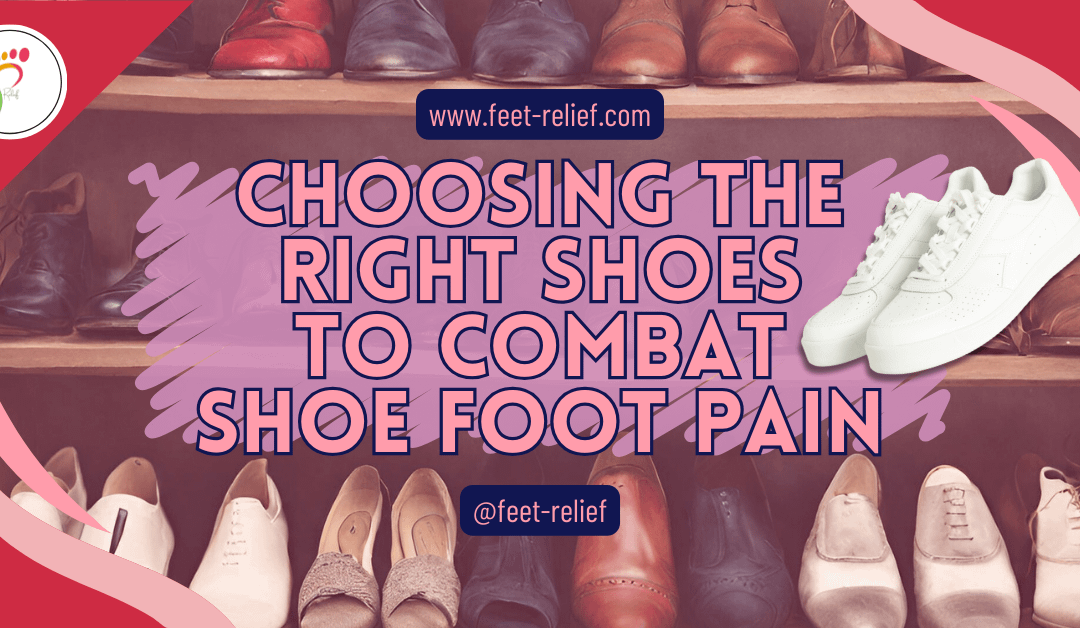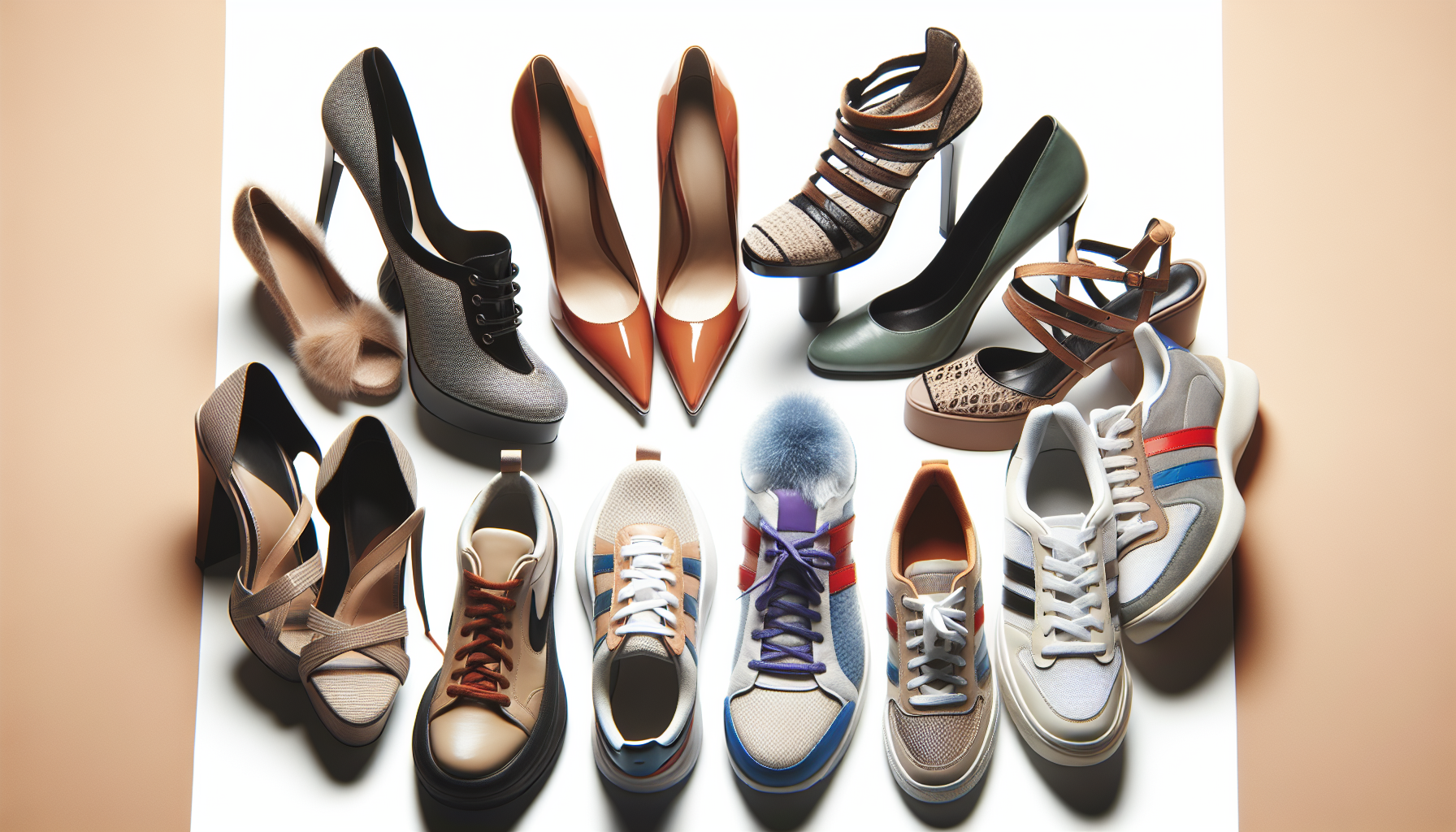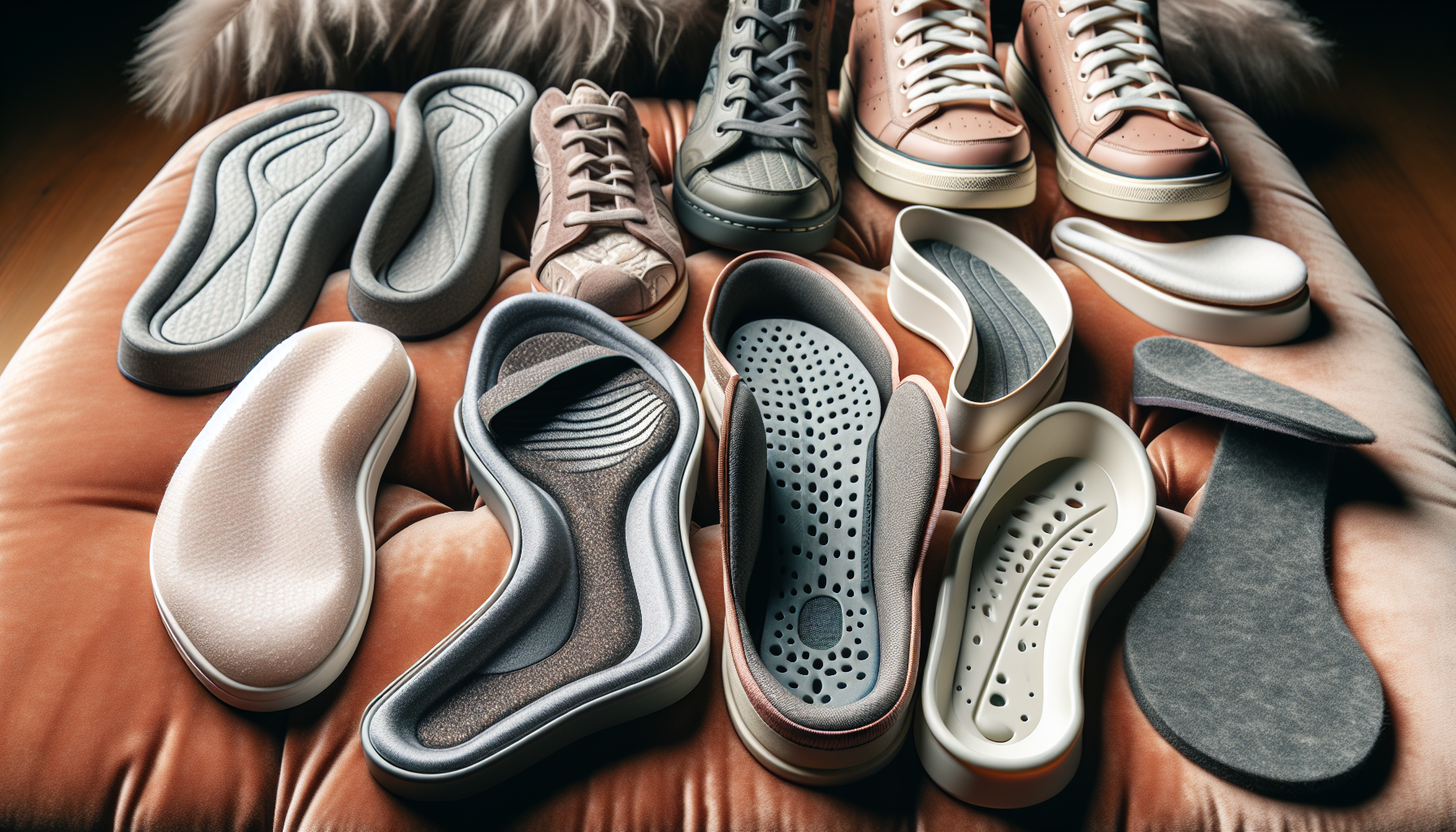Feet-Relief is supported by our audience. When you purchase through one of our links, we may earn a small affiliate commission. As an Amazon Associate I earn from qualifying purchases.Your cost is not affected.
Choosing the right shoes isn’t just about style; it’s about ensuring foot health and combating pain. Whether you’re dealing with common discomforts like blisters, bunions, plantar fasciitis, or chronic conditions such as diabetes, finding the perfect pair tailored to your needs is crucial. In this guide, we’ll explore critical factors to consider in selecting shoes that alleviate foot pain and promote overall foot health.
Each step impacts our body, making proper footwear crucial. Understanding the anatomy of foot pain and the supportive features of shoes, from arch support to cushioning, empowers us to make informed choices that prioritize comfort and fit. Join us as we navigate the world of shoes to find the perfect blend of comfort, support, and style for your unique needs.
Stepping out of Discomfort: Choosing the Right Shoes to Combat Shoe Foot Pain
Are your shoes causing foot pain? Many people endure soreness and discomfort due to ill-fitting shoes, lack of support, or wrong shoe design. This feature will guide you through identifying why your footwear may be the source of your pain and offer actionable steps to choose shoes that bring comfort instead of pain. Let’s tackle shoe foot pain head-on with clarity and simplicity.

Key Takeaways
- Ill-fitted shoes, inappropriate arch support, and unhealthy shoe designs contribute to a range of foot problems such as corns, calluses, bunions, hammertoes, and plantar fasciitis, highlighting the importance of wearing properly fitted and supportive footwear.
- Foot pain, beyond causing immediate discomfort, can lead to long-term health issues affecting alignment and mobility; thus, choosing the proper footwear and considering using orthotics is crucial for preventing and alleviating foot-related conditions.
- Professional help should be sought for persistent foot pain, especially when self-care adjustments do not alleviate symptoms or if underlying health conditions such as diabetes might complicate foot health.
Shoe-Related Foot Pain: Identifying the Causes
Foot pain can creep into our lives in many ways, often stemming from our shoes. Ill-fitted shoes, for instance, are a leading cause of foot discomfort that can affect our daily lives and overall body alignment. And it’s not just about sore feet. Wearing tight shoes all day can alter our body’s alignment, potentially causing back and hip pain. But that’s not all. Tight shoes can also create a sweaty and smelly environment ideal for bacterial and fungal infections like athlete’s foot.
The wrong shoes can create a domino effect, leading to a multitude of health issues. For example, shoes’ lack of proper arch support can lead to flat feet and other foot problems. Similarly, shoe designs that do not consider the natural contours and arches of the foot can cause long-term foot issues. The solution to these issues begins with understanding the problems caused by poorly fitted shoes, inadequate arch support, and harmful shoe designs.

Poorly Fitted Shoes
Imagine squeezing your feet into shoes that are too small for you. The discomfort is immediate. Wearing shoes that are too tight or small can lead to a host of foot problems like:
- corns
- calluses
- bunions
- hammer-toes
Poorly fitting shoes can crowd the feet, restrict their flexibility, and increase the risk of friction and foot pain.
The right fit, on the other hand, ensures comfort and flexibility. Finding a pair of properly fitting shoes that corresponds to your foot’s natural shape is vital when selecting footwear. Additionally, ensure there is approximately ½ inch of space between your longest toe and the shoe’s tip. This space allows for foot movement without sliding and avoids tightness.
Lack of Arch Support
The arches of our feet are like the springs in a car. They absorb the shock every time our foot hits the ground. Proper arch support in footwear acts as a shock absorber, providing stability and balance and enhancing overall posture and athletic performance. Without adequate arch support, we may experience the collapse or strain of our natural arch, leading to flat feet and pain extending from the feet to the lower back.
Foot arches come in various shapes—normal, flat, and high—each requiring a different level of support to ensure foot comfort and proper function. That’s where arch supports come in. These devices help to distribute pressure across the foot evenly and are a common non-invasive remedy for alleviating foot pain and treating foot conditions.

Unhealthy Shoe Designs
Have you ever wondered why some shoes, despite being your size, just don’t feel comfortable? That’s probably because the design of the shoe doesn’t account for the natural contours and arches of your foot. Unhealthy shoe designs often lack sufficient arch support, leading to an increased risk of foot problems, especially when worn on hard, flat surfaces.
Shoe designs can also affect the weight distribution and stability provided by arch support. Improper designs can lead to discomfort and foot conditions. So, while it can be tempting to choose shoes based solely on their design, it’s vital to consider the impact on your foot health.
Common Foot Conditions Caused by Inappropriate Footwear
The wrong shoes can do more than just cause temporary discomfort. They can lead to long-term damage, deformities, and foot conditions. Some common foot conditions caused by inappropriate footwear include:
- Bunions
- Hammertoes
- Plantar fasciitis
- Ingrown toenails
Choosing the right shoes to prevent these conditions and maintain foot health is essential.
Foot injuries caused by ill-fitting shoes can require days, even weeks, for proper healing. Shoes lacking adequate cushioning can result in a range of foot conditions, such as:
- blisters
- calluses
- corns
- shin splints
- plantar fasciitis
- Achilles tendonitis
Tight shoes can even lead to peripheral neuropathy, a painful condition affecting the nerves of the feet. The wrong footwear can also result in fractures, sprains, and strains. The damages can be severe, affecting not just the feet but also the body’s alignment and overall health.

Bunions and Hammertoes
Bunions and hammertoes are painful foot deformities often worsened by narrow shoes that crowd the toes. A bunion, known medically as Hallux Valgus, is a bony enlargement at the base of the big toe that causes it to angle towards the second toe. On the other hand, Hammertoes result from an imbalance in the toe muscles, causing the toes to bend at the middle joint. Tight shoes that force toes into a curled position, like high heels or narrow footwear, can exacerbate these conditions.
Preventing bunions and hammertoes involves choosing shoes that fit well, without being too tight or long, and featuring a wide toe box to reduce pressure on the toes. So, while those narrow, pointy-toed shoes might look stylish, they could set you up for a lifetime of foot pain.
Plantar Fasciitis and Heel Pain
Each year, over 2 million people are affected by plantar fasciitis, a common cause of intense heel pain. This condition is a widespread issue that many individuals experience. It’s characterized by inflammation of the plantar fascia, a band of tissue that runs from the heel to the ball of the foot. Inflammation can occur due to:
- Overuse
- Prolonged standing on hard surfaces
- Age-related changes
- Wearing unsupportive footwear such as flip flops or overly flexible flats or sneakers
This can lead to discomfort and potential injury.
Proper footwear with adequate arch support is crucial in preventing overstretching, tearing, or inflammation of the plantar fascia, thus avoiding plantar fasciitis. Here are some tips for choosing the right shoes to prevent plantar fasciitis:
- Look for shoes with good arch support
- Choose shoes with a cushioned sole to absorb shock
- Make sure the shoes have a firm heel counter to provide stability
- Opt for shoes with a wide toe box to allow for natural foot movement
- Consider using orthotic inserts for additional support
By ensuring your shoes offer adequate support to your feet, you can significantly reduce the risk of developing plantar fasciitis.

Ingrown Toenails and Corns
Tight shoes can also cause other painful conditions like ingrown toenails and corns. An ingrown toenail occurs when the toe rubs constantly against the shoe, causing friction. Similarly, friction from a restricted toe box in tight shoes leads to the development of corns and calluses.
Corns typically form on the top or sides of toes and are characterized by a hard center with inflamed surrounding skin, often aggravated by narrow footwear and high heels. These conditions lead to significant foot discomfort and can be prevented by wearing properly fitted footwear.
So, the next time you feel a pinch in your toe, remember that your shoes might be the culprit!
Tips for Choosing the Right Shoes to Prevent Foot Pain
Having comprehended the issues inappropriate footwear can cause, we can now explore the process of selecting the right shoes to avert foot pain. It’s not as daunting as it seems. The key lies in prioritizing comfort and fit, opting for supportive features, and considering activity-specific footwear.

To ensure an accurate fit, follow these steps:
- Measure both feet.
- Accommodate the larger foot.
- Focus on a precise fit rather than relying on shoe size numbers.
- Shoes should fit well and feel comfortable immediately, avoiding the notion that shoes need to be ‘broken in.’
- Try on shoes towards the end of the day when feet are most swollen to ensure a comfortable fit throughout the day.
Opt for supportive shoes that provide a firm foundation with in-built arch support to enhance stability and balance. And remember, selecting shoes that lace up can offer more support than slip-ons.
Prioritize Comfort and Fit
In the realm of footwear, nothing trumps comfort. Prioritize comfortable shoes as soon as you put them on, and do not cause pain or discomfort during or after wearing them. This indicates a good fit and sufficient cushioning. Have your feet professionally measured at a shoe store to ensure the correct size and width. And remember, foot sizes can change, so consider getting remeasured periodically.
Trying on various brands and styles with the socks you plan to wear can help ensure a perfect fit. Look for a finger-width gap between your big toe and the shoe’s edge to avoid tightness and allow foot movement without sliding. If the heel slips while walking, consider consulting a fitter for advice.
Opt for Supportive Features
Footwear with supportive features significantly contributes to preventing foot pain. Built-in arch support in shoes is more effective for foot health than inserts, as specialty stores can properly fit insoles if necessary. Good cushioning and shock-absorbing soles are crucial for protecting the feet against impacts.
Shoes that offer a good fit and stability help prevent injury and discomfort by ensuring that the foot does not roll or twist easily. Thick soles and extra padding, especially in the midsole, provide essential arch support and reduce injury risk during physical activity.
Consider Activity-Specific Footwear
Choosing the right type of shoe for specific activities is essential in averting foot pain and ensuring proper support. Here are some tips for choosing the right shoes for different activities:
- For walking, choose walking shoes that are comfortable from the start and have a wide toe box.
- For running, choose running shoes with a wide toe box, allowing for a half inch of space from your longest toe, and providing proper cushioning and support.
- It’s best to purchase running shoes at specialized stores that offer a gait analysis and treadmill test.
For cold or work-related activities, boots with thick soles and cushioned padding can provide optimal arch support and protection for the entire foot. So, whether you’re hitting the gym, hiking, or dancing the night away, choosing the right shoes for the activity can make all the difference in your foot health.
Adjusting Your Current Shoes for Better Foot Health
But what if foot pain is already an issue? Is it possible to modify your current shoes to improve foot health? Absolutely! Upgrading to a properly fitted and comfortable athletic shoe can be a critical initial step in alleviating foot pain.
Additionally, you can improve foot health by using shoe inserts and orthotics, maintaining proper shoe care, and gradually stretching and breaking in new shoes.

Shoe Inserts and Orthotics
The utilization of shoe inserts and orthotics can dramatically enhance foot health. Custom orthotics are tailored to enhance foot function by providing targeted support, precise alignment, and ample cushioning, aiding in the even distribution of weight across the foot. These can improve your gait by supporting the arch and aligning the ankle and foot, which can have a beneficial effect on knee, hip, and back alignment.
Using orthotics is not only a strategy for immediate relief but also a proactive approach to maintaining long-term foot health and preventing the onset of more severe conditions. Arch support inserts are an accessible solution for enhancing shoe comfort; they come in various designs to match the distinct arch types of different individuals. So, if you’re struggling with foot pain, custom orthotics or shoe inserts might be worth considering.
Proper Shoe Maintenance
A bit of tender loving care can significantly prolong your shoes’ lifespan. Worn-out shoes with reduced cushioning can lead to decreased support and indicate the need for replacement to ensure continued foot and ankle health. Regularly cleaning shoes, especially after exposure to moisture or dirt, is vital for preserving their material and appearance. You can even apply a waterproofing treatment to your shoes to prevent moisture damage and thereby extend the life of the footwear.
To extend the durability of your shoes and ensure they continue to offer the necessary support and comfort, consider the following:
- Resoling shoes can help to maintain their structure and prevent excessive wear and tear.
- Replacing the Velcro can rejuvenate the shoe’s fastening mechanism and effectively stabilize the foot.
- Rotating your shoes regularly can help to maintain their shape, lessen wear and tear, and ensure they provide proper support for a longer time.
By following these tips, you can keep your shoes in good condition for an extended period.

Stretching and Breaking In
While breaking into new shoes may seem daunting, it need not be so. It should be a gradual process to avoid creating pressure points that can lead to blisters or other forms of foot discomfort. Wearing new shoes for short periods and gradually increasing the time spent in them helps the feet to adapt without causing too much pain.
There are also several methods to stretch shoes gently at home. Shoe stretchers can be used to stretch tight areas of a shoe, making them more comfortable. Applying heat with a hairdryer to the tight areas of a shoe can make it more flexible and help it conform to the shape of the feet.
Remember, when you wear shoes, they should be comfortable immediately upon trying them on and not rely on being broken in later.
Video Credit: @PositiveMotionChiro
When to Seek Professional Help for Shoe Foot Pain
One should never disregard foot pain. If you experience any of the following, it might be time to consider seeking professional help:
- Persistent foot pain
- Flat feet or high arches
- Worn-out shoes
- Prolonged standing
- Foot deformities
- Plantar fasciitis
- Previous foot or ankle injuries
- Aching legs or back
Severe foot pain or swelling, especially following an injury, requires immediate medical attention when your feet hurt.
Symptoms of infection such as:
- redness
- warmth
- tenderness
- presence of a fever
These are also signs that you should seek a physician’s care. Medical consultation is advised if foot pain hinders walking or bearing weight on the foot. If foot or ankle pain persists and does not improve with over-the-counter treatments, seeking a consultation with a podiatrist is advisable.
Persistent or Worsening Pain
Persistent or escalating foot pain is a definitive signal to seek medical attention. Some common indicators that you may need orthotics include:
- Persistent foot pain
- Flat feet or high arches
- Worn-out shoes
- Prolonged standing
- Foot deformities
- Plantar fasciitis
- Previous foot or ankle injuries
- Aching legs or back
If you are experiencing any of these symptoms, consulting with a medical professional about the possibility of using orthotics may be beneficial.
Changes in walking patterns or gait as a result of foot pain warrant a visit to a foot care specialist for proper assessment and treatment options. Medical intervention should be considered if home remedies do not diminish foot pain caused by injury or overuse.
Underlying Conditions
Individuals with underlying conditions, especially diabetes, must exercise extra caution regarding foot health. Diabetics with peripheral neuropathy require shoes that minimize the risk of infection and support poor circulation to manage foot pain effectively. Regular podiatric care is crucial for diabetics to prevent diseases and treat complications associated with foot health, such as dry skin, ingrown toenails, and wounds.
Professional consultation is essential for persistent arch problems or foot pain to assess the necessary level of arch support. Early detection of foot pain in children, followed by the provision of arch supports, can avert more serious foot issues later on. So, don’t hesitate to seek professional help if you experience persistent foot pain or have underlying conditions that could affect your foot health.
Prioritize Foot Health by Choosing the Right Shoes
In conclusion, your feet carry you throughout your life, so why not treat them right? Choosing the right shoes can reduce foot pain, prevent severe foot conditions, and improve your overall foot health. Remember, comfort and fit are paramount, and it’s worth taking the time to find shoes that offer both. If you experience persistent foot pain or have an underlying condition like diabetes, don’t hesitate to seek professional help. Take care of your feet, and they’ll take care of you.
Frequently Asked Questions
How do you fix foot pain from shoes?
To fix foot pain from shoes, try applying ice, elevating your foot, wearing well-fitting shoes, using foot pads, and reducing activity until the pain subsides. Additionally, consider wearing shoe inserts, getting medical injections, taking pain relievers, and avoiding activities that aggravate the pain.
Can wrong shoes cause leg muscle pain?
Yes, wrong shoes that do not fit properly can cause leg muscle pain as the muscles work harder, leading to fatigue and pain. It’s essential to wear proper footwear to prevent foot pain and take care of your body.
How can I choose the right shoes to prevent foot pain?
To prevent foot pain, prioritize comfort and a proper fit when choosing shoes. Look for supportive features like built-in arch support and good cushioning, and consider the specific activity you’ll be doing.
When should I seek professional help for shoe foot pain?
You should seek professional help for shoe foot pain if it persists, does not improve with home remedies, or causes changes in your walking patterns. It’s essential to consult a healthcare provider if you have underlying conditions like diabetes.
What are some common foot conditions caused by inappropriate footwear?
Wearing inappropriate footwear can lead to foot conditions like bunions, hammertoes, plantar fasciitis, and ingrown toenails. It’s important to choose footwear that supports the natural shape of your feet.
Unlock the secrets to happier, healthier feet on our website, feet-relief.com! From tips on choosing the right shoes to expert advice on managing foot conditions, this is your ultimate resource for all things foot-related. Don’t let foot discomfort slow you down – visit our website and empower yourself with the knowledge you need for lasting relief!
Amazon and the Amazon logo are trademarks of Amazon.com, Inc, or its affiliates.









